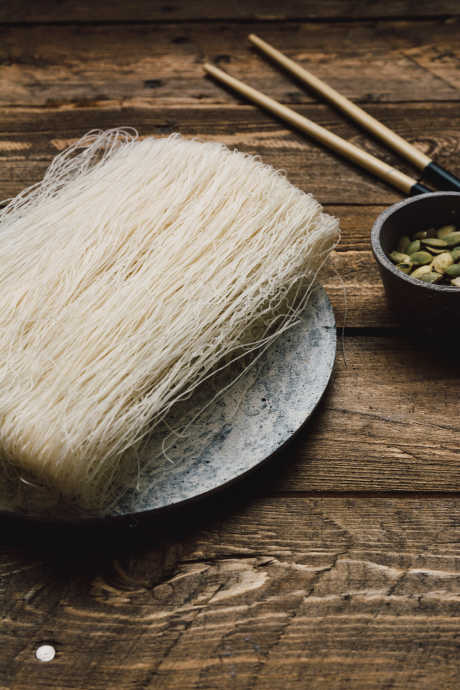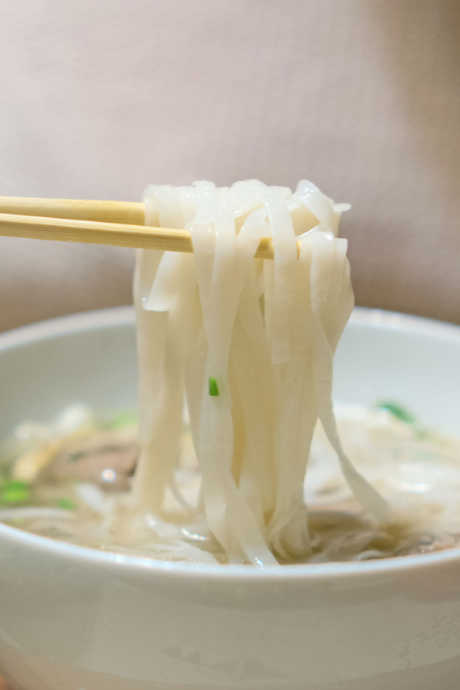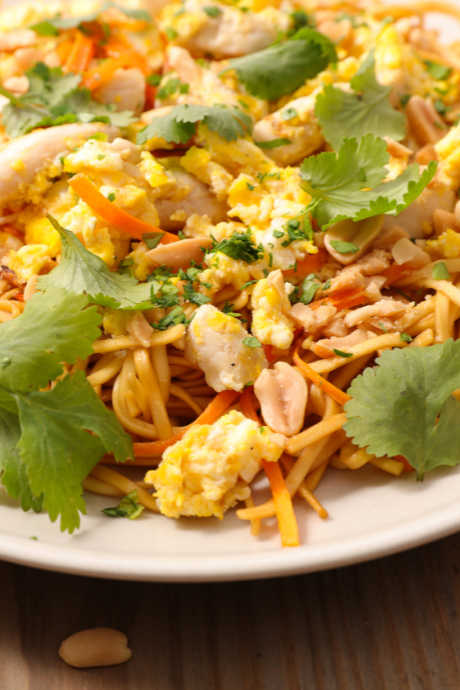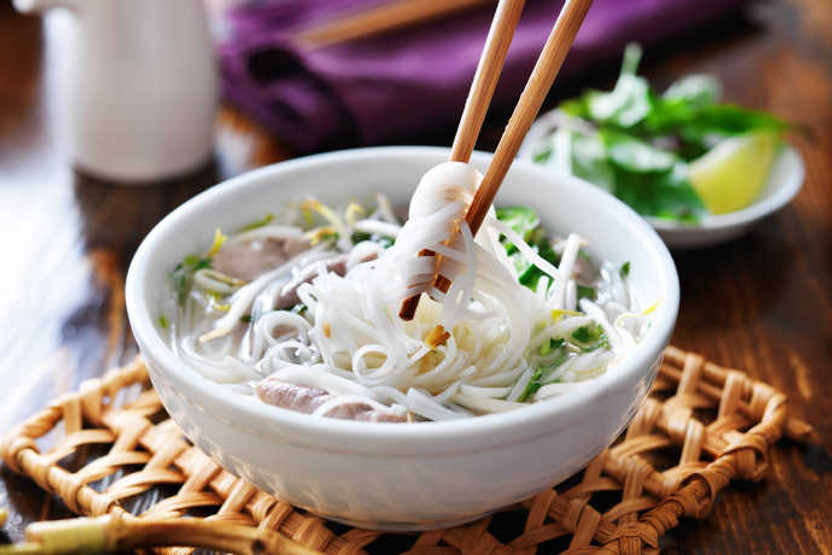Rice Noodles: An Asian Cooking Essential
Posted by Julie on Jul 19th 2019
Rice noodles aren’t merely a gluten-free alternative to traditional wheat pasta. They’re an essential ingredient in a variety of hot and cold Asian dishes. However, they can be a bit tricky to work with. We’ll share the tips and tricks we found for cooking rice noodles, along with three recipe suggestions to check out.
Ways to Cook Rice Noodles
We found two primary ways of cooking rice noodles. While one may be a better option than the other depending on the recipe you’re making, let’s start by explaining both of them.
1. Pour Over
The first option for cooking rice noodles is to place them in a heat-proof bowl and pour boiling water over them. Let them soak a minute or two, and then stir gently. Repeat until they are soft, and taste to check the texture. As with wheat pasta, you’ll want a different amount of “bite” depending on how you’re going to use your noodles. Likewise, thinner rice noodles will take less time to cook than thicker flat ones.

When your noodles are cooked to your satisfaction, drain and rinse them in cold water. Make sure it’s cool enough to halt the cooking process. Rinsing your noodles also helps wash away excess starch, which is what makes them stick together. You can also toss them with a bit of oil to help prevent sticking.
2. Boil
You can boil rice noodles just as you would boil wheat pasta, but be ready to pull them right back out of the water. Even thicker flat rice noodles don’t require much time to cook.
However, most of our sources recommended soaking and rinsing the noodles before boiling, regardless of how thick or thin they are. While you don’t have to use hot water to soak them, this step is similar to the cooking method above. Soaking and rinsing removes excess starch, which cuts down on stickiness.
Once you add your rice noodles to the boiling water, stir to help separate them and ensure they cook evenly. Drain and rinse them right away to make sure they don’t get mushy.
Other Cooking Considerations
Because it matters whether you’ll use your rice noodles in a hot dish or a cold one, pay attention to the cooking time and target tenderness specified in your recipe. For example, if you plan to add sauce to your noodles and stir fry them, leave them a bit undercooked. They’ll cook some more in the wok, and if they’re already tender, they may turn out mushy by the time your dish is finished. If you’re making soup, you can add the dry noodles directly to the simmering broth. However, we’d be inclined to soak and rinse them first, to help avoid ending up with a big clump of noodles stuck together in your broth.

On the other hand, noodles destined for cold dishes won’t get another turn in a hot pan. Fully cook these rice noodles. Even if they seem a bit soft when you drain them, they will firm up some more when they’re cool.
While you can leave your cold noodles in a colander, tossed with a splash of oil, we love this brilliant idea from Runaway Rice: Use a salad spinner to dry and toss them! Then you can spread your noodles on a baking tray or plate until you’re ready to use them.
Finally, you can turn rice noodles into a crunchy topping for salads. Fry them in a heavy-bottomed pan or wok on the stovetop.
Rice Noodle Recipes to Try
Now that you know how to wrangle rice noodles, it’s time to put those skills to work on a few dishes. We picked out a couple classic recipes and one wild card to share. They all sound great to us, and we hope you enjoy them too.
Weeknight Pad Thai
We found this recipe in Bon Appetit’s “Basically” section, which is one of our favorite places to find simple, straightforward recipes for staple dishes. That said, there’s one ingredient in this recipe that may require an extra stop, and that’s tamarind. You can use tamarind juice or add water to tamarind paste. It has an intense sweet-sour flavor that’s essential to many Asian dishes, including Pad Thai. Your local grocery store may have it, but you’re sure to find it at an Asian market. The rest of the ingredients, including scallions and fish sauce and bean sprouts, should be easy enough to find.

This recipe calls for the pour-over method of cooking the rice noodles, which is a smart way to control how tender they are before adding them to the stir fry. Even so, rinse your noodles to remove excess starch and help keep them separate when you add them to the sauce. Toss some leftover shredded chicken or cooked shrimp into the mix if you like. While it won’t be the same as takeout, it’s a delicious weeknight approximation without the added cost.
Vietnamese Rice Noodle Salad
This recipe from Food52 is an alternative to traditional pasta salad, and it’s filled with cool, crisp ingredients, ideal for a hot summer day. Consider doubling or tripling it if you plan to serve more than two people. We’d also suggest combining all the ingredients in a single serving bowl rather than trying to portion it individually.
Soak and rinse your rice noodles, and then boil them briefly. The recipe calls for spreading them on a towel to dry, but we’d also give them a turn in the salad spinner before, as recommended above. Add napa cabbage, carrots, and cucumbers to the noodles; you can slice them thin, or try spiralizing the carrots and cucumbers.
Toss everything with dressing made from fish sauce, fresh lime juice, brown sugar, garlic, and a minced Thai chile. If you can’t find Thai chiles, substitute a serrano pepper. Spread cooked chicken, fish, or shrimp over the top, and garnish with coarsely chopped peanuts. This salad would also be good with fried rice noodles on top.
Coconut Curry With Rice Noodles and Garden Vegetables
While this dish from Half Baked Harvest is another hot one, we think it’s ideal for summer because it includes vegetables from your garden, farmer’s market, or this month’s co-op box. You can use whatever you have, whether that’s zucchini, corn, beans, peppers, tomatoes, cucumbers, carrots, or something else. This recipe reminds us of goulash, Thai-style.
While there’s no specific directions given for cooking the rice noodles, we recommend the pour-over method since these noodles will be smothered in sauce. Leave them a little undercooked so they can absorb the flavor of the sauce without getting soggy. Speaking of the sauce, you’ll want to have Thai red chile paste, fish sauce, and coconut milk on hand, along with honey and lime juice. Then add the protein of your choice (or leave it out), and ladle the sauce and vegetables over your noodles. We love how simple and versatile this dish is.
 Free shipping over $49
Free shipping over $49










